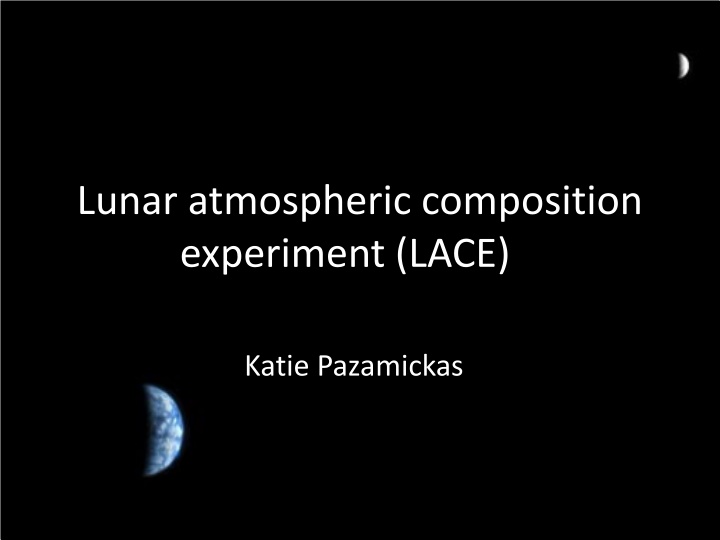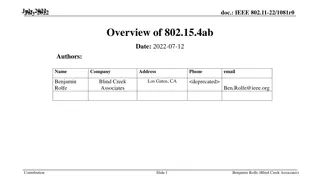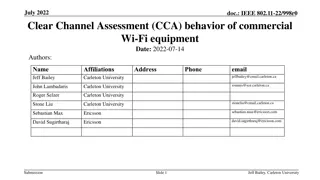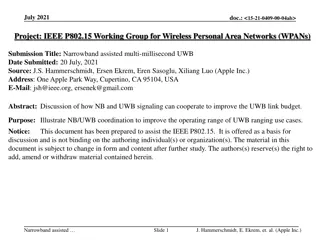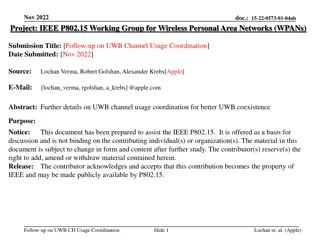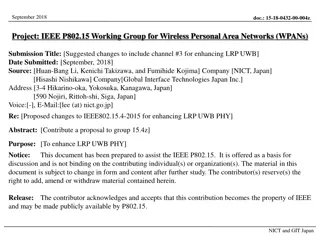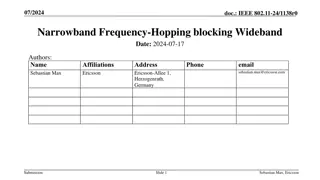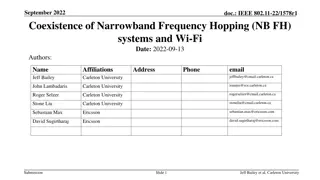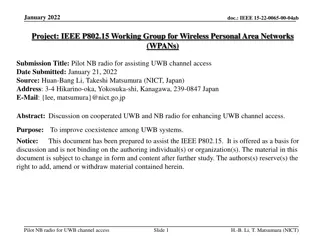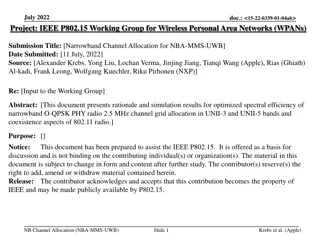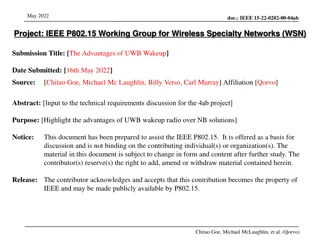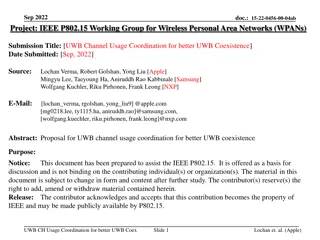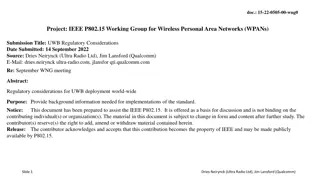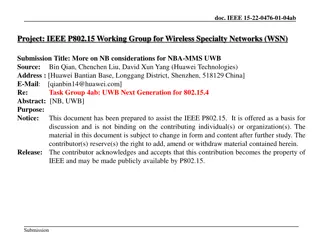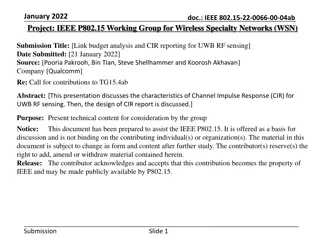Narrowband Channel Hopping for NB-Assisted UWB
This document presents proposals for efficient narrowband channel hopping in NB-assisted UWB to enhance link budget and support various use cases with improved accuracy, reliability, and power consumption. It outlines the three phases of NB-assisted UWB and suggests strategies for interference mitigation and improved coexistence.
Download Presentation

Please find below an Image/Link to download the presentation.
The content on the website is provided AS IS for your information and personal use only. It may not be sold, licensed, or shared on other websites without obtaining consent from the author.If you encounter any issues during the download, it is possible that the publisher has removed the file from their server.
You are allowed to download the files provided on this website for personal or commercial use, subject to the condition that they are used lawfully. All files are the property of their respective owners.
The content on the website is provided AS IS for your information and personal use only. It may not be sold, licensed, or shared on other websites without obtaining consent from the author.
E N D
Presentation Transcript
Lunar atmospheric composition experiment (LACE) Katie Pazamickas
LACE Flew on Apollo 17 as a part of ALSEP. Deployed in the Taurus- Littrow Valley (30 45 53.6 E and 20 11 31.6 N) Turned on Dec. 27, 1972 at 18:07
The moon has an atmosphere? Gas molecules travel in ballistic trajectories between collisions with the lunar surface classic exosphere. Sources come from solar wind, lunar volcanism or meteoroid impacts. No dipolar magnetic field, however once every lunar orbit the moon will pass through the Earth s magnetotail for approximately 6 days.
How LACE Works Gas molecules enter and are ionized by an electron bombardment ion source, collimated into a beam and sent through a magnetic analyzer to a detection system. 3 mass ranges scanned simultaneously.
LACE Data Each record consists of 90 x 16 array of numbers, or 1440 numbers, with only 1330 numbers of actual data. 1330 steps, with a time between steps of .6 sec 10 steps of background and 10 steps of internal calibration are inserted between sweeps A sweep is 13.5 min Time is in milliseconds starting from ?
Amu Calculations 4 1 ( ) = 12 Mass AR : 4 1 amu n 1329 48 ( ) = Mass BR : 48 1 amu n 1329 110 27 4 . ( ) = Mass CR : 110 1 amu n 1329
Daily Graphs Analysis Time chart created in Excel file:///H:/Documents/Katie%20Presentation%202 010/Daily%20Graphs/MASSAR/dailygraphsmassa r.html file:///H:/Documents/Katie%20Presentation%202 010/Daily%20Graphs/MASSBR/dailygraphsmassb r.html file:///H:/Documents/Katie%20Presentation%202 010/Daily%20Graphs/MASSCR/dailygraphsmasscr .html
Moonquakes/Meteoroid Impacts Moonquakes leak gasses into the atmosphere, only one moonquake (Feb 1, 1973) took place while LACE was on/geographically near LACE and no major differences were noted. Meteoroid Impacts stir up dust and particles in the lunar atmosphere. Events were analyzed during common meteor showers, with no major differences noted.
Transient Lunar Phenomena Short lived changes in the brightness of patches on the surface of the moon Observed on Jun 6, 1973 near LACE file:///H:/Documents/NASA/Jun%206/MASSAR/j une6massar.html file:///H:/Documents/NASA/Jun%206/MASSBR/ju ne6massbr.html file:///H:/Documents/NASA/Jun%206/MASSCR/ju ne6masscr.html
Aug 20-Sept 3 H2 10000 1000 100 10 1 125 156 187 218 249 280 311 342 373 404 435 466 497 528 559 590 621 652 683 714 745 776 807 838 869 900 931 962 993 1024 1055 1086 1117 1148 1179 1210 1241 1272 1303 1334 1365 1396 1427 1458 1489 1520 1 32 63 94
Aug 20 - Sept 3 H2O 10000 1000 100 10 1 125 156 187 218 249 280 311 342 373 404 435 466 497 528 559 590 621 652 683 714 745 776 807 838 869 900 931 962 993 1024 1055 1086 1117 1148 1179 1210 1241 1272 1303 1334 1365 1396 1427 1458 1489 1520 1 32 63 94
Aug 20 - Sept 3 MASSBR 40Ar 10000 1000 100 10 1 125 156 187 218 249 280 311 342 373 404 435 466 497 528 559 590 621 652 683 714 745 776 807 838 869 900 931 962 993 1024 1055 1086 1117 1148 1179 1210 1241 1272 1303 1334 1365 1396 1427 1458 1489 1520 1 32 63 94
Aug 20 - Aug 31 MASSCR 40Ar 1000 100 10 1 121 151 181 211 241 271 301 331 361 391 421 451 481 511 541 571 601 631 661 691 721 751 781 811 841 871 901 931 961 991 1021 1051 1081 1111 1141 1171 1201 1231 1261 1291 1321 1351 1381 1411 1441 1471 1501 1531 1 31 61 91
100000 40Ar Lunations 1 - 5 5th Lunation 1st Lunation 2nd Lunation 3rd Lunation 10000 4th Lunation 1000 100 10 1 103 137 171 205 239 273 307 341 375 409 443 477 511 545 579 613 647 681 715 749 783 817 851 885 919 953 987 1021 1055 1089 1123 1157 1191 1225 1259 1293 1327 1361 1395 1429 1463 1497 1531 1565 1599 1633 1667 1701 1 35 69
40Ar Lunations 6 - 9 6th Lunation 7th Lunation 8th Lunation 9th Lunation 10000 1000 100 10 1 125 156 187 218 249 280 311 342 373 404 435 466 497 528 559 590 621 652 683 714 745 776 807 838 869 900 931 962 993 1024 1055 1086 1117 1148 1179 1210 1241 1272 1303 1334 1365 1396 1427 1458 1489 1520 1 32 63 94
Paper Graph Analyzed graph in Apollo 17 PSI Slight differences in mass numbers were noticed
Aug 20 - Aug 31 41.2 AMU 10000 1000 100 10 1 125 156 187 218 249 280 311 342 373 404 435 466 497 528 559 590 621 652 683 714 745 776 807 838 869 900 931 962 993 1024 1055 1086 1117 1148 1179 1210 1241 1272 1303 1334 1365 1396 1427 1458 1489 1520 1 32 63 94
Thank You! Dr. Dave Williams Dr. Kent Hills Dr. Ed Grayzeck Cori Quirk
